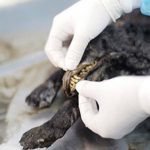Early Special Effects
Long before CGI, labor laws, and unions, Hollywood studios took some serious risks with their actors and stunt persons’ lives to create the money shot. In the early days, health and safety regulations didn’t exist. For quite some time, stunt performers didn’t even exist. Even when they did, many movies didn’t use them because they either didn’t have the money to pay a stunt performer, or they didn’t want to pay the price. This led to some deadly scenes over the years.
Across the Border
When a movie called Across the Border was being shot in 1914, actress Grace McHugh was caught in quicksand on the Arkansas River while filming. The cameraman, Owen Carter, tried to save her, but he couldn’t. Instead, he ended up in the quicksand also, and they died together. Despite this horrific incident, the film was still released.
Failed and Successful Stunts
Actress Martha Mansfield was 24 years old when she was killed on the set of The Warrens of Virginia. She was wearing a Civil War-era costume, which was not fireproof. When someone tossed a match near the actress, her dress went up in flames, and she died in the hospital. Most actors were forced to put themselves in dangerous situations like this, and surviving hazardous conditions were part of the job. Pearl White and early stunt performer was known as “the peerless, fearless girl.” When another stunt performer died on her set, and she didn’t, it only gave her more notoriety.
Actor Harold Lloyd became famous when he blew two of his fingers off, but continued to perform. He was also famous for hanging from a clock tower in Los Angeles. He really did this, but he was closer to the ground than he appeared. Stunts had to be carefully planned if they were going to be executed safely.
They Died With Their Boots On
While filming the movie, They Died With Their Boots On in 1941, three people died. Jack Budlong was one of them. He was a good friend of the film’s star, Errol Flynn. Rather than using a prop sword, he insisted on using a real one. When his horse got spooked while filming a scene that required a fake explosion, he was thrown off the horse. The real sword went right through his stomach, and he died in the hospital shortly after.
A Turning Point
In 1982, while filming Twilight Zone: The Movie, a helicopter crash killed actor, Vic Morrow, and two child actors, Myca Dinh Le and Renee Shin-Yi Chen. It turned out that the director who hired the children was violating child labor laws. This tragedy led the Directors Guild of America to create a helpline where directors could be advised on safety issues. Thanks to this, people were being penalized for not following health and safety directions. Because of this, on-set accidents dropped significantly. This doesn’t mean there haven’t been deaths since. Brandon Lee was filming The Crow in 1993, and someone neglected to clean a gun properly. This caused a tiny piece of a bullet to shoot Lee, killing him.
Stunt performers were also killed while filming The Expendables 2 and Deadpool 2. Although accidents can still happen on set, it is much less common than it once was. It wasn’t just dangerous stunts that put people at risk decades ago. Even the scenery was incredibly dangerous.
The First Method Of Creating Falling Snow
Gently falling snow is essential for creating a beautiful movie scene. Years ago, CGI was not available, so people had to get creative. The first material used for fake snow was cotton. Although it isn’t dangerous, when it piles up, it can create a fire hazard. Firefighters were the ones who pointed this out.
Real Snow
In 1925, Charlie Chapman starred in The Gold Rush. The film required a lot of snow, and some of the scenes were shot on location with real snow. The film used 600 extras, most were homeless people from Sacramento, battled the snow for real. This led the moviemakers to want to find a way to recreate snow on-set.
Cornflakes and Foamite
Moviemakers believed that cornflakes would make great snow. After painting the cornflakes white, they looked just like falling snow. The only problem was that they made a crunching sound when you stepped on them. When Frank Capra was directing, It’s a Wonderful Life, he wanted lots of snow, but he didn’t want the crunching noise. Since the movie was filmed in the middle of July, real snow wouldn’t be an option. Capra mixed foamite, which is the material found in fire extinguishers, with water, sugar, and soap flakes. When pumped in with a high-pressure wind machine, it looked just like real snow. They used 6,000 gallons to cover the ground, and it even left footprints when the actors walked. The RKO Effects Department won an award for the fake snow they created.
Asbestos
A more natural, less expensive alternative for the snow was asbestos. Today, we know that this is a very toxic material. When the microscopic fibers are breathed in, it can cause severe lung conditions and cancer. Years ago, people didn’t know how dangerous asbestos was, and it was often used to make fake snow. In the 1940s, people were aware that asbestos was dangerous, but they didn’t realize just how dangerous it was, so they continued to use it.
The Wizard Of Oz
The Wizard Of Oz was filmed in 1939. To this day, it is one of the most iconic movies of all time. The Library of Congress has called it the most-seen film of all time. Despite its popularity, the working conditions were deplorable. The producers didn’t want Judy Garland to gain weight, so they controlled her daily food intake and often called her fat. They even gave her diet pills.
As if this weren’t enough, the actors were exposed to asbestos on set. Ray Bolger, who played the Scarecrow, had his whole costume made of asbestos because they believed that it would make it fire-proof. The Wicked Witch’s broom was also made from asbestos. They also used a lot of it to create snow. Jack Haley Jr., the son of the Tin Man actor, Jack Haley, died of respiratory failure in 2001. Many people believe that his father brought home asbestos particles on his clothes, exposing his son. By the ’90s, asbestos manufacturers went bankrupt because the material is hazardous. It is also no longer used to make fake snow. This Old Movie Trick Was A Hollywood Favorite – But It Could Have Killed Dozens Of Actors.


